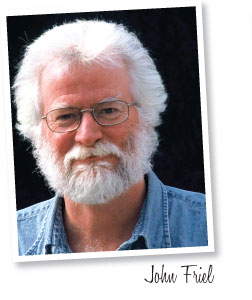1/1/2020
An Uphill Battle
John Friel

Confession: I sometimes feel like a bit of a fraud. I love plants. I sell them, write about them, photograph them, even lecture on them ... but I’m not a very active gardener.
Perhaps I suffer from Impostor Syndrome, the mysterious sense of unworthiness that afflicts even very high achievers in the arts and business. Or perhaps I’m a real fake whose every train of thought needs a grain of salt.
Occasionally, I make up for lost time. This November and (gulp) early December, I tackled a slope behind my home, a steep patch of typical Lancaster County clay. We boast the world’s most fertile dry farmland, but it’s frustrating stuff to work with: clingy as tar when wet, brittle as brick when dry. And limestone, our bedrock, always lurks just below the surface. There’s a quarry across my river.
When neglected, this too-steep-to-mow bank becomes a waist-high weedy eyesore. I’ve been guilty of that neglect the last two years, hence this fall’s dramatic intervention. After lots of ripping out, hacking back and mulching, here’s a partial list of what went into that slope.
Ajuga reptans
Apologies to native purists, but an assertive, butt-kicking groundcover was called for here. Hence, two varieties of bugleweed. If, after a few years, it’s become a monoculture of this Asian import, so be it. Better ajuga than a jungle.
Callicarpa americana
When I first saw beautyberry at a cut flower conference, I thought someone had dyed the berries that improbable purple. But, no, that’s their natural hue. Clustered on woody stems, they’re striking on the bush or in a vase. The scientific and common names are synonyms in different languages: Callicarpa = beautiful seed.
Deutzia Nikko
A great little shrub and a marketing lesson. At a previous employer, I attempted with little success to graft woodies onto our perennial starter lineup. We did our homework and chose genera like deutzia, itea and spirea—compact woodies that work well in gallon perennial programs. To our chagrin, we found that we simply weren’t front-of-mind for that product. There’s woody, and there’s herbaceous, and the twain meet but rarely in liner buyers’ consciousness.
Amsonia Butterscotch (trademarked)
This one solves a problem I didn’t know existed with A. hubrichtii, a Perennial Plant of the Year winner: Tip die-back. Consciousness raised, I started looking more closely. Sure enough, even in some world-class public gardens that shall remain anonymous, the tips of A. hubrichtii were distorted, wizened, browned out. This one has the same breeze-tossed froth of fine green summer foliage, but segues into a richer, deeper autumnal tone. I mixed it with grasses (miscanthus and panicum) near the top of the slope. Having seen it used to good effect as a grass companion, I’m optimistic that it’ll look great—if it doesn’t die because I stupidly waited ‘til December to plant it.
Begonia grandis
The very idea of hardy begonia tickles me, probably because of the years I spent selling non-hardy types. Reiger, Rex, wax—all those tender, succulent-stemmed house and bedding plants left me unprepared. And, in fact, this one’s kind of a crapshoot, even though it went in early in the process. Some swear it’s hardy here in Zone 6b, while others say it’s died each time they’ve tried it. A half-zone farther south, it’s a sure thing, but here? Ask me in May.
When I stood and straightened, I was surprised by how much discomfort working at such an angle can cause. The uphill battle left my glutes feeling as if someone had literally kicked my butt.
I wonder if that happens to real gardeners. GP
John Friel is marketing manager for Emerald Coast Growers and a freelance writer.